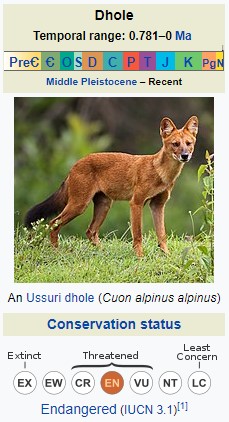Focus: GS-III Environment and Ecology, Prelims
Why in news?
Karnataka, Maharashtra and Madhya Pradesh rank high in the conservation of the endangered dhole in India, according to a study.
Details
- Scientists found that Karnataka, Maharashtra and Madhya Pradesh were adequately equipped to maintain their high ranks in consolidating forest habitats and recover dhole populations by increasing prey density and reducing the pressure on forests.
- On the other hand, the study said, Arunachal Pradesh, Chhattisgarh, Odisha, Telangana and Goa will need to increase financial investments in the forest and wildlife sectors, and reduce the ease of granting forest clearances for infrastructure projects.
- It also found that improving habitat conditions and prey densities in the Eastern Ghats of Andhra Pradesh, Telangana and Odisha would “strengthen the link” between dhole populations in the Western Ghats and central India.
Dhole

- The dhole is a canid native to Central, South, East Asia, and Southeast Asia.
- Other English names for the species include Asian wild dog, Asiatic wild dog, Indian wild dog.
- It is listed as Endangered in the IUCN Red List.
- In India, the dhole is protected under Schedule 2 of the Wildlife Protection Act, 1972.
- During the Pleistocene, the dhole ranged throughout Asia, Europe, and North America but became restricted to its historical range 12,000–18,000 years ago.
- The dhole is a highly social animal, living in large clans without rigid dominance hierarchies.
- Factors contributing to this decline include habitat loss, loss of prey, competition with other species, persecution due to livestock predation and disease transfer from domestic dogs.
- The dhole occurs in most of India south of the Ganges, particularly in the Central Indian Highlands and the Western and Eastern Ghats. It is also present in Arunachal Pradesh, Assam, Meghalaya, and West Bengal and in the Indo-Gangetic Plain’s Terai region.
- In Central Asia, the dhole primarily inhabits mountainous areas.
-Source: The Hindu



